ASRock Industrial NUC BOX-1260P and 4X4 BOX-5800U Review: Alder Lake-P and Cezanne UCFF Faceoff
by Ganesh T S on August 5, 2022 8:15 AM EST- Posted in
- Systems
- AMD
- Intel
- UCFF
- Mini-PC
- ASRock Industrial
- Cezanne
- Alder Lake-P
Power Consumption and Thermal Characteristics
The power consumption at the wall was measured with a 4K display being driven through the HDMI port of the system. In the graph below, we compare the idle and load power of the ASRock Industrial NUC BOX-1260P and 4X4 BOX-5800U with other systems evaluated before. For load power consumption, we ran the AIDA64 System Stability Test with various stress components, as well as our custom stress test with Prime95 / Furmark, and noted the peak as well as idling power consumption at the wall.

The numbers are consistent with the TDP and suggested PL1 / PL2 values for the processors in the systems, and do not come as any surprise. With a 64W PL2, the NUC BOX-1260P has the highest load power consumption. The choice of components (such as a Gen 4 SSD) also contribute to the higher idle power numbers. The Cezanne system is not that far behind, with a peak of around 75W despite a much lower PL2. It is likely that the Ryzen 7 5800U treats the configured power range as only a suggestion, and tries to go much higher (as high as 54W) as long as thermal headroom is available.
Stress Testing
Our thermal stress routine is a combination of Prime95, Furmark, and Finalwire's AIDA64 System Stability Test. The following 9-step sequence is followed, starting with the system at idle:
- Start with the Prime95 stress test configured for maximum power consumption
- After 30 minutes, add Furmark GPU stress workload
- After 30 minutes, terminate the Prime95 workload
- After 30 minutes, terminate the Furmark workload and let the system idle
- After 30 minutes of idling, start the AIDA64 System Stress Test (SST) with CPU, caches, and RAM activated
- After 30 minutes, terminate the previous AIDA64 SST and start a new one with the GPU, CPU, caches, and RAM activated
- After 30 minutes, terminate the previous AIDA64 SST and start a new one with only the GPU activated
- After 30 minutes, terminate the previous AIDA64 SST and start a new one with the CPU, GPU, caches, RAM, and SSD activated
- After 30 minutes, terminate the AIDA64 SST and let the system idle for 30 minutes
Traditionally, this test used to record the clock frequencies - however, with the increasing number of cores in modern processors and fine-grained clock control, frequency information makes the graphs cluttered and doesn't contribute much to understanding the thermal performance of the system. The focus is now on the power consumption and temperature profiles to determine if throttling is in play.
Our first look is at the NUC BOX-1260P. The power consumption and temperature plots against time are presented below.
The system is able to easly handle CPU-only and CPU+GPU loading. However, GPU-only loading ramps up the temperature close to the junction (105C), with the package power having to throttle slightly to keep the temperature in check. This was not seen in AIDA64's system stress test components.
Moving on to the 4X4 BOX-5800U, we first look at the temperature and power consumption plots for the system configured with the default BIOS options (Normal mode).
The CPU package power tracking (PPT) and package power consumption numbers reported by HWiNFO seem highly unreliable in the context of the independently recorded at-wall power consumption. We make some inferences based on the temperatures and the at-wall power numbers. It is clear that the system 'throttles' as soon as the package temperature hits 95C. The GPU-only loading scenario is not as stressful as it was for the Alder Lake-P system. It appears that the system is able to sustain 65W at the wall when both CPU and GPU are loaded, while keeping the temperature of the package around 95C.
Finally, we see the behavior of the same parameters when the same stress sequence is applied with the CPU operating mode set to 'Performance' in the BIOS.
The performance mode appears to set the sustainable at-wall power consumption number around 68W. The cooling solution is good enough for the configured PL1 / PL2 values, but it can't keep up with the 54W maximum target TDP of the Ryzen 7 5800U for a long time.


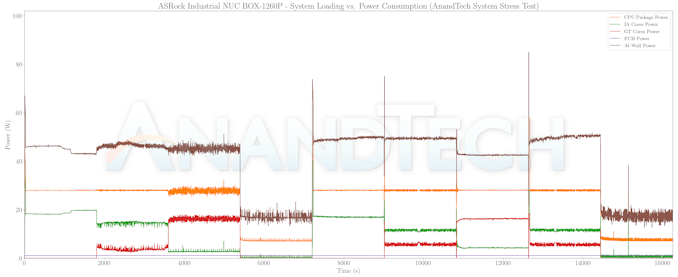
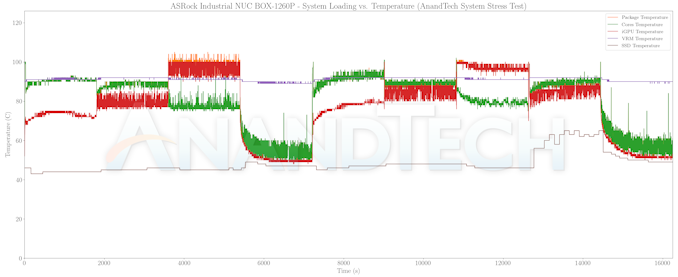
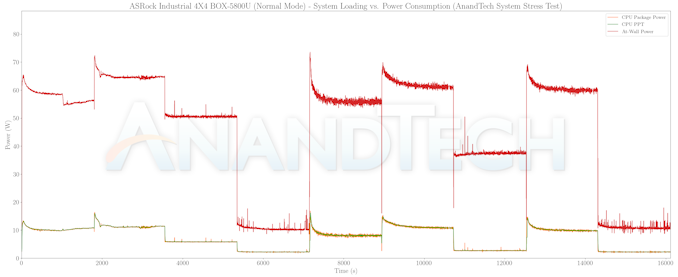
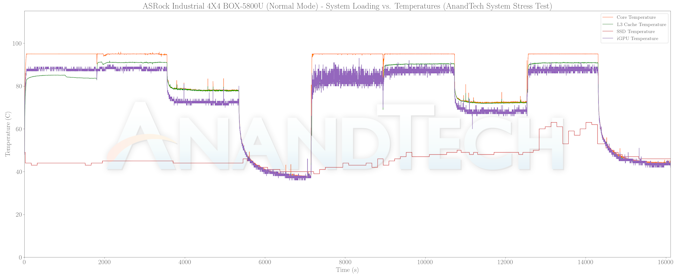
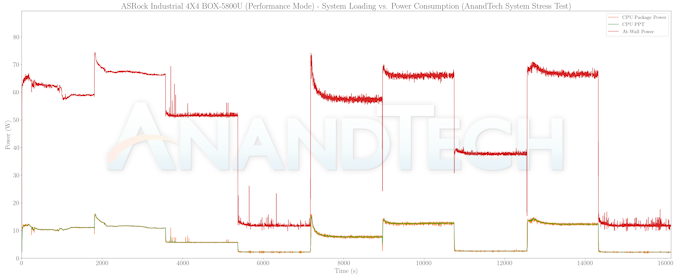
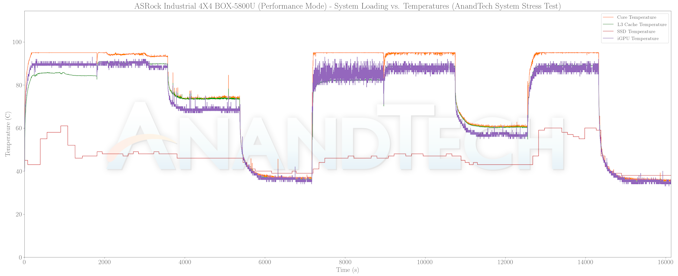








34 Comments
View All Comments
erotomania - Saturday, August 20, 2022 - link
Very nice writing, Ganesh. I enjoyed reading the whole article, and I perhaps most enjoyed the section on storage. I would read more, just sayin'.Oxford Guy - Sunday, August 21, 2022 - link
'Due to the variation in configured power limits for both processors, it is not possible to do a scientific apples-to-apples comparison for each benchmark.'And the differences between the SSDs.
Oxford Guy - Sunday, August 21, 2022 - link
Perhaps I missed it. Where is the decibel-to-performance data, or even a simple noise under tough real-world workload chart?stan_dman - Wednesday, August 24, 2022 - link
Impressive little pc's. I'd be interested how noisy the cooling is. I had an optiplex 7050 with i5-7500t (tdp 35w) gave me a headache with a whiny fan.